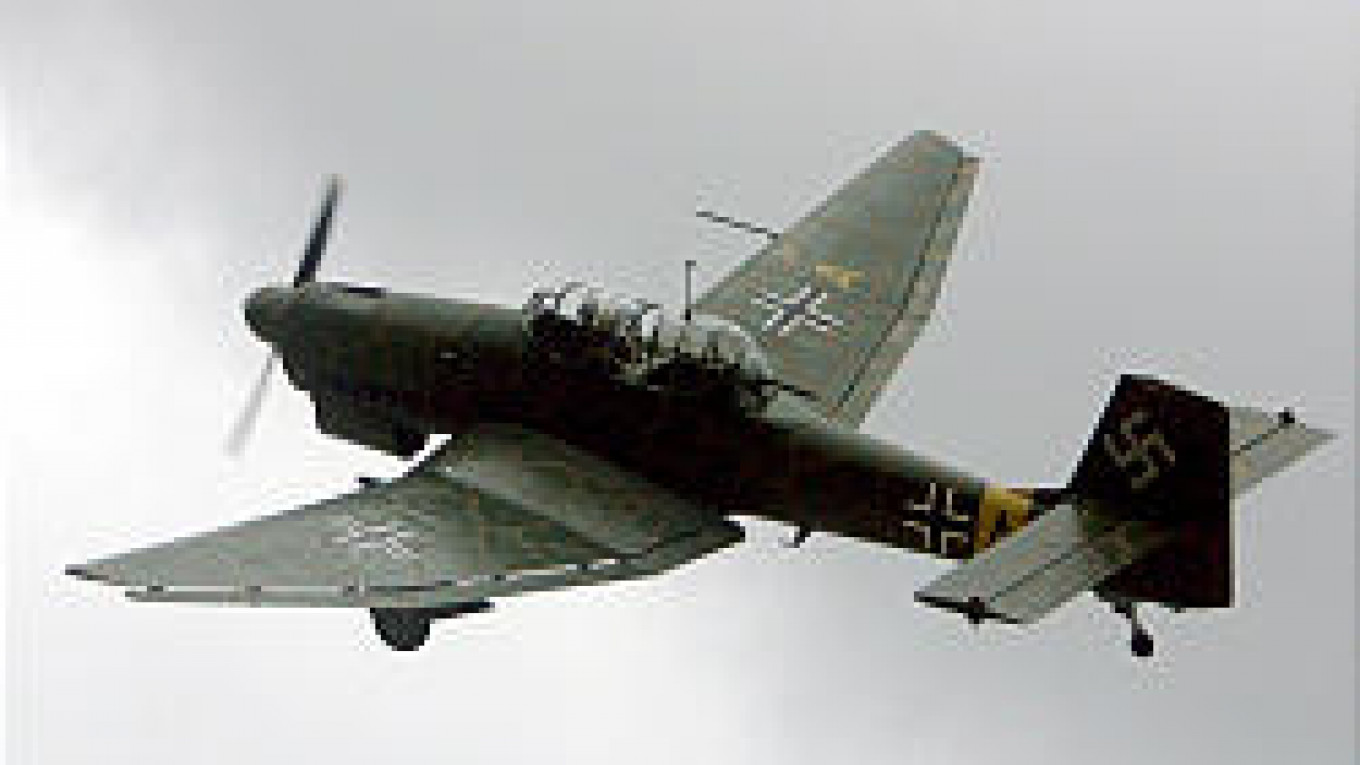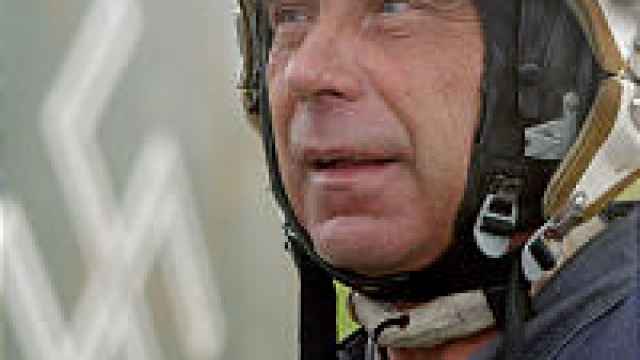With its swastikas gleaming in the sun, the plane bears down on Ukrainian soil once again and drops its load -- a huge bomb.
It does not explode.
Instead it bounces, and the handful of flying fanatics gathered on the center verge of a ramshackle aerodrome in southern Ukraine laugh, saying all it could kill was a rabbit.
"That's why the Germans lost the war," chuckles one -- Farkhad the engineer, who has downed tools to watch retired army pilot Vladimir Nesonov fly his homemade Junkers complete with a bomb, crafted out of wood and metal.
Rubbing his eyes as Nesonov swoops down again frighteningly close to the ground, Farkhad stares at the plane and mumbles: "How strange to see a Nazi plane in the sky again."
For many in Ukraine, seeing a Nazi dive-bomber screeching through the sky stirs memories of the destruction wrought by Hitler's Luftwaffe air force and ground troops in World War II.
But for Nesonov it is the realization of a dream -- he has built a Junkers plane out of bits of scrap scavenged in Russia's Far North, and after several unsuccessful attempts he can fly a model of the dive-bomber that inflicted so much damage during the war.
"My mother saw pictures of me flying the plane and panicked, thinking for a second it had all started again," says Nesonov, cradling a vodka after flying in circles for about 10 minutes around the aerodrome.
"But what I can do is show the world what it was like, the sheer fear," he says. "Loads of people ask me how I can fly a fascist plane, but I say we have to remember the fierce plane that nearly killed us all."
He hopes filmmakers will use the replica -- "and not just any old Russian plane with swastikas stuck on" -- to show the world what the war meant for ex-Soviet Ukraine, a country whose suffering during the war, he says, has rarely been talked about.
About one in six of Ukraine's population was killed during the war, some 5.3 million people. The war tore the republic apart, dividing those who fought for the Soviets and those who wanted out of the Union and helped the Nazis.
Today the war is still hitting the headlines after officials in a town in western Ukraine brought forward the idea of rehabilitating veterans of the Nazi SS Galicia division -- something that has caused outrage among many.
Nesonov's father was wounded in battle at the front. He now lives alone in the industrial Zaporozhiya region and refuses to talk of what happened after the Germans invaded in 1941.
Maybe that's why Nesonov is obsessed with "the enemy." But he puts it more simply -- he chose the plane because of its power.
"I chose the Junkers because it's a plane of the aggressor. It was the plane that the fascists used to destroy almost the whole of Europe. It even got to Africa and England," he says, flinging his arms wide to stress his point.
"The bombs are so accurate it is like shooting someone in the back of the head. ... If we [the Soviet Union] had had these kind of machines, the war would have been a different matter. We would have kicked the Nazis out much more quickly."
|
| Reuters Retired army pilot Vladimir Nesonov. |
Painted with green and yellow camouflage, black crosses on both sides and swastikas on the tail, the plane is slightly smaller than a real Junkers but is equipped with guns and bombs.
"It's just like a real Junkers and I can fly it just like a Luftwaffe pilot."
Most watching the strange spectacle would disagree.
Donning a white helmet with huge black goggles, he looks more like a "Star Wars" bad guy than a pilot. Then his army buddy Vladimir Aksyonenko, a.k.a. "The Colonel," helps him into the cockpit and fusses over him like a child.
"Put your seatbelt on ... no don't tug it like that ... there you are," he murmurs, climbing off the wing.
With a put-put, the engine starts ticking over with a strong smell of fuel and a burst of black smoke. It cuts out. The first attempt, second, third and fourth fail to get the engine working and then its back to the hangar for some heavy-duty repair work.
"It's a pretty weak engine. It's a four-cylinder," engineer Farkhad says, cut short by a blustering Nesonov who shouts out that the world should believe it has 12 cylinders.
Again to the taxiway, The Colonel runs around the plane with screwdriver in hand, making some final adjustments.
Chugging down the runway and slowly taking off, the plane looks poised to fall to the ground.
"He's a kamikaze," says Farkhad. The Colonel breathes a heavy sigh of relief when the pilot just about manages to pull the plane out of a deep dive.
"I'll kill him myself if he doesn't do it first," says The Colonel, decked out in camouflage fatigues and sandals.
After 10 minutes flying, Nesonov gets out of the cockpit with his arms raised above his head and a huge grin across his face.
"So how was it?" he asks the crowd. "Did you see what I did? Filmmakers must see what I can do to make their films more realistic. ... I am ready for all offers."
A Message from The Moscow Times:
Dear readers,
We are facing unprecedented challenges. Russia's Prosecutor General's Office has designated The Moscow Times as an "undesirable" organization, criminalizing our work and putting our staff at risk of prosecution. This follows our earlier unjust labeling as a "foreign agent."
These actions are direct attempts to silence independent journalism in Russia. The authorities claim our work "discredits the decisions of the Russian leadership." We see things differently: we strive to provide accurate, unbiased reporting on Russia.
We, the journalists of The Moscow Times, refuse to be silenced. But to continue our work, we need your help.
Your support, no matter how small, makes a world of difference. If you can, please support us monthly starting from just $2. It's quick to set up, and every contribution makes a significant impact.
By supporting The Moscow Times, you're defending open, independent journalism in the face of repression. Thank you for standing with us.
Remind me later.



